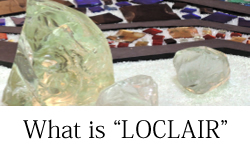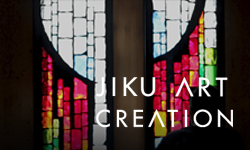Media Coverage
TV
MBS「Catch!!」July 27th 2019



July 27, 2019 (Saturday) broadcast from 9:54 pm on MBS
Jiku Art Creation is an architectural glass art production studio that has inherited the technique of “Loclair”, a luxurious stained glass with richness in design.
Jiku Art Creation appeared on a TV program called Catch !!
TV
February 6, 2014 (Thursday) broadcast from 7:58 pm on TV Osaka “Wafu-sohonke”



February 6, 2014 (Thursday) broadcast from 7:58 pm on TV Osaka
“Wafu-sohonke” Made-in-Japan found in the world a special feature about America
Keiko Miura's artwork “tree of life” in Seattle was introduced and the production scene in the studio was broadcast.
Newspapers / magazines / books
Asahi Shimbun Hibiki Kikou (2013/2/16) Saturday evening

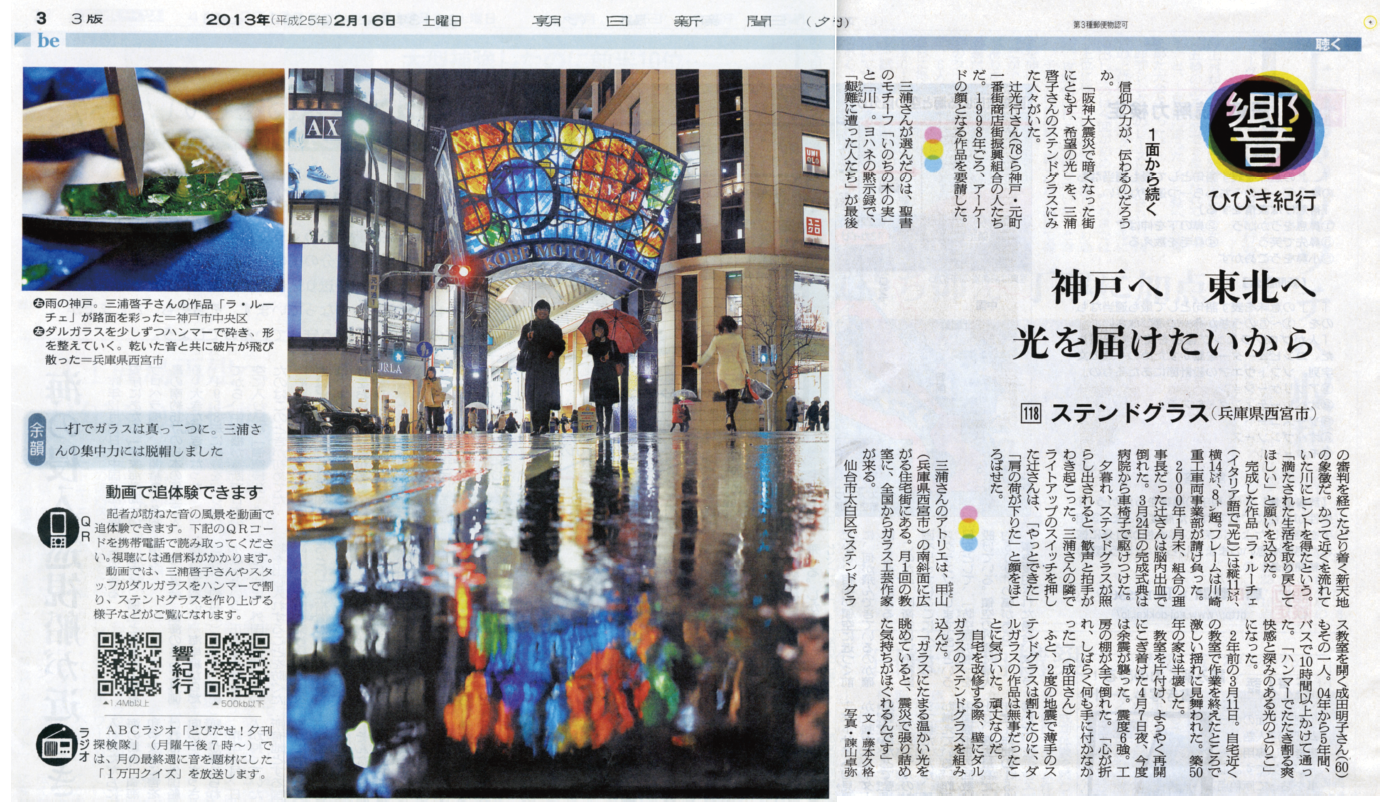
Newspapers / magazines / books
Asahi Shimbun Hibiki Kikou (2013/2/16) Saturday evening
It looks like a slice of brick.
However, from the rainbow color emitted by sunlight, it can be seen that it is certainly glass.
Holding a glass of dull ("paving stone" in French) on the knee, Keiko Miura (77 years old) is hitting a hammer with a sharp tip like a spear.
Gradually, a plate-like glass (thickness of about 2 cm, length 20 cm, width 30 cm) changes its shape. Each one will be part of a masterpiece "Lambs gathering around Christ", 4 meters long and 2 meters wide.
Ordinary stained glass is obtained by cutting about 5 mm thick glass with a cutter and pasting small pieces of glass. It is thin and the cut surface is constant, so it is transparent but somehow monotonous.
But dull glass is different. The thickness softens the light, and the wavy cut surface adds complex diffuse reflection.
She was tied with a Christian husband and gained faith in her 20s. Faced with God, she saw the “powerful world of light rising in my heart”.
She wanted to express it and challenged with oil painting. She also learned the usual stained glass when she went to the US with her husband. But all are different. Around that time, she heard about thick glass and went to France. Seeing the real thing, perhaps coming up with the world's first attempt. It was around 1970.
"I was paid no attention back then." But now, over 1800 works for churches, concert halls, and schools. A “powerful world of light” is spreading throughout the world.
Matching the cut dull glasses to the background. Careful work by craftsman continues. (Nishinomiya City, Hyogo Prefecture)
There were people who saw Keiko Miura's stained glass as "light of hope in the city darkened by the Great Hanshin Earthquake." Those people included Mr. Mitsuyuki Tsuji (78 years old) and others from Kobe and Motomachi Ichiban Shopping Street Promotion Association. Around 1998, he requested a work that would be the face of an arcade.
Keiko Miura chose the biblical motifs “fruit of life” and “river”. In the Revelation of John, it is a symbol of a new place where “the people who went through hardships” arrived after the final judgment. She was inspired by a river that used to flow nearby the shopping center. “I want everyone in Kobe to regain his fulfilled life”.
The completed work “La Luce” (“light” in Italian) is 11 meters long, 14 meters wide, over 8 tons. The frame was contracted by Kawasaki Heavy Industries Vehicle Division.
At the end of January 2000, Mr. Tsuji, who was the president of the union, collapsed due to bleeding within the brain. He arrived in a wheelchair from the hospital for the completion ceremony on March 24.
When the stained glass was illuminated at dusk, cheers and applause began. Mr. Tsuji who pressed the light-up switch next to Keiko Miura broke into a broad smile, "I finally got it. That’s load off my shoulders”
Keiko Miura's atelier is in a residential area on the south slope of Kabutoyama (Nishinomiya City, Hyogo Prefecture). Glass craftsmen from all over the country come to the classroom once a month.
One of them is Akiko Narita (60 years old), who holds a stained-glass class in Tashiro-ku, Sendai City, Miyagi Prefecture. For 5 straight years from 2004 she is taking Keiko Miura’s class. It takes her more than 10 hours ride by bus. She is captivated by “Good feeling of smashing with a hammer and the light with depth”.
Two years ago, on March 11th, when she finished work in a classroom near her home, she was hit by a violent shake. The 50-year-old house was partially destroyed.
The aftershock struck this night on the night of April 7, when the classroom was cleared and finally reopened. The earthquake measured a upper 6 on the 7-point Japanese scale and all shelves in the workshop collapsed. “My heart broke and I wasn’t myself for a while” (Mrs. Narita)
Suddenly, I noticed that the stained glass works made of dull glass were safe while the ordinary stained glass made of the thin glass collapsed in two earthquakes. It is sturdy.
When renovating the house, a stained glass of dull glass was incorporated into the wall.
“When I look at the warm light that accumulates in glass, I can relax the feelings of tension in the earthquake.
On rainy day in Kobe, Keiko Miura's work “La Luce” decorated the road. Chuo-ku, Kobe City.
Crush the dull glass little by little with a hammer and shape it. Debris splattered with a dry sound. Nishinomiya City, Hyogo Prefecture.
Sankei Shimbun Hyogo has this person (2011/11/29)
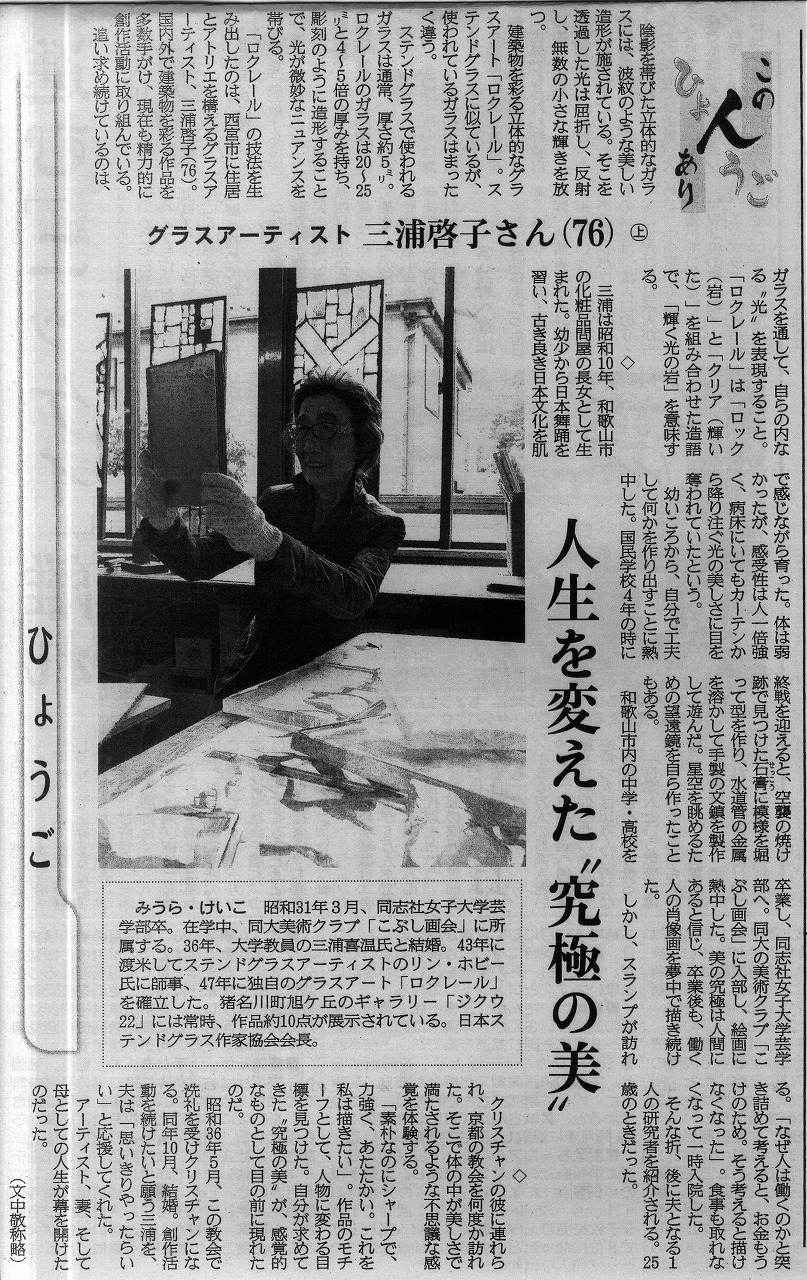
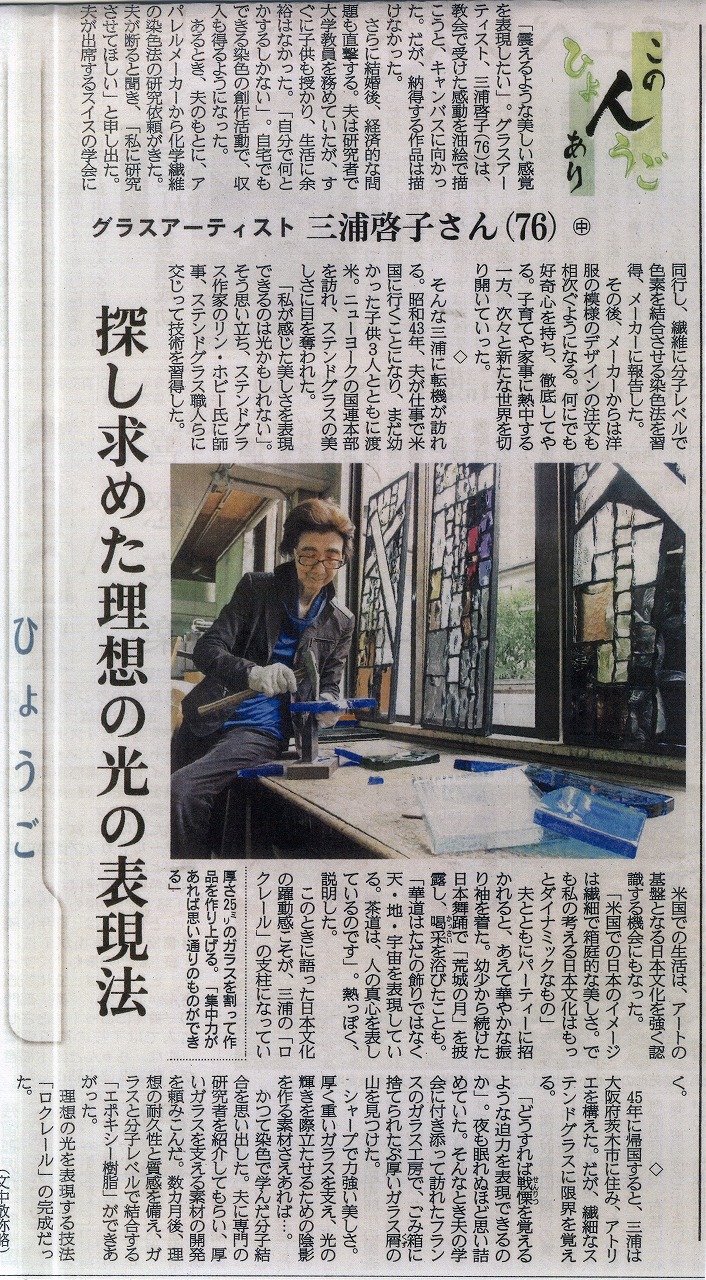
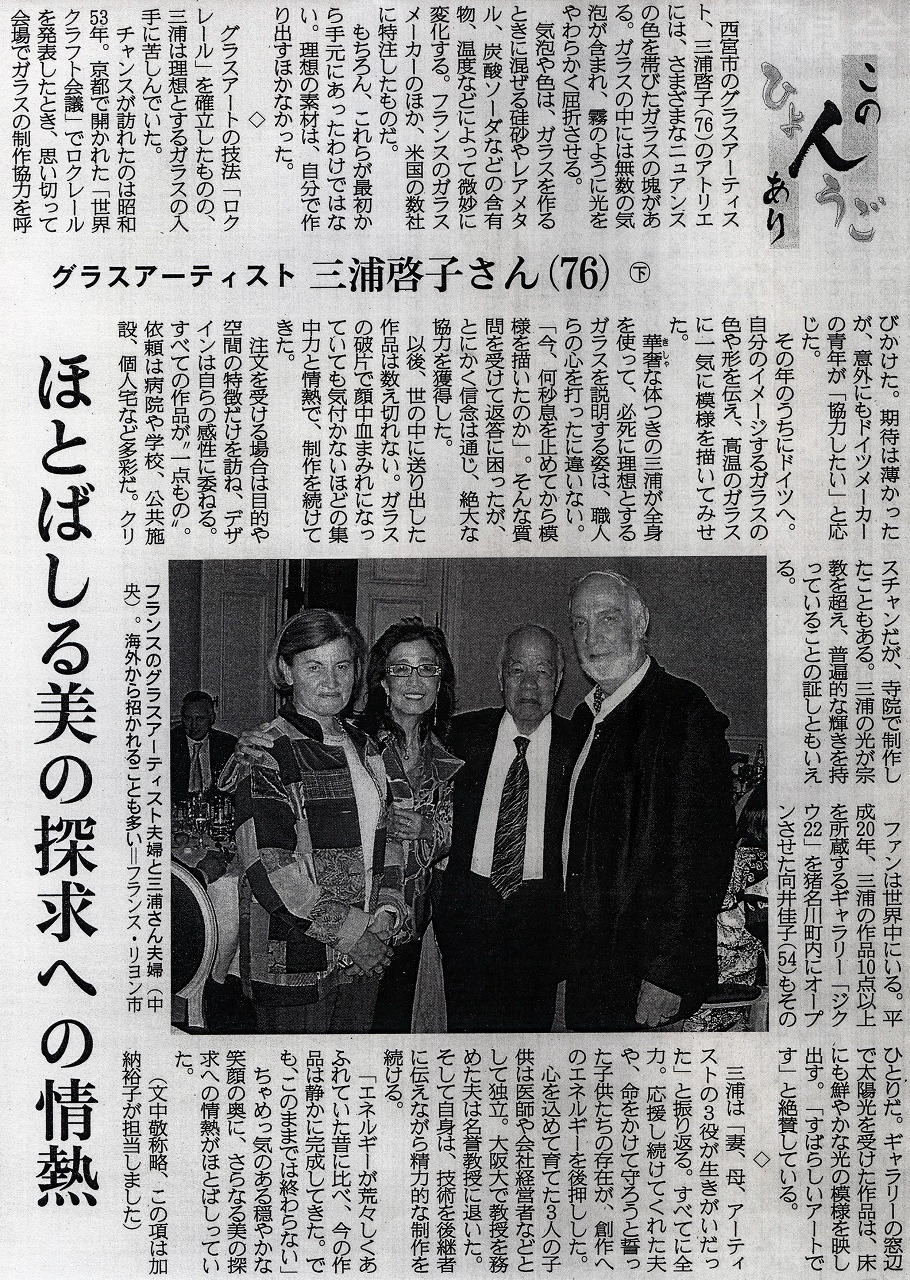
Newspapers / magazines / books
Sankei Shimbun Hyogo has this person (2011/11/29)
(1/3)
The shaded, three-dimensional glass is beautifully shaped like ripples. The light that passes through it is refracted, reflected, and emits countless small sparkles.
Three-dimensional glass art "Roclair" that colors buildings. Similar to stained glass, but the glass used is completely different.
The glass used for ordinary stained glass is usually 5mm thick. “Roclair”'s glass is 20 to 25 mm thick, 4 to 5 times as thick as the ordinary stained glass, and is shaped like a sculpture, giving the light a subtle nuance.
It is Keiko Miura (76) that created the technique of “Roclair”. She is a glass artist with a residence and atelier in Nishinomiya City.
She has produced many works that decorate buildings both in Japan and overseas, and is still actively engaged in creative activities.
What she continue to pursue is expressing her inner “light” through glass.
“Roclair” is a coined word that combines “Rock” and “Clear” and means “Rock of Sparkling Light”.
Miura was born in 1934 as the eldest daughter of a cosmetics wholesaler in Wakayama City. She learned Japanese dance from a young age and grew up feeling good old Japanese culture with her skin.
Although her body was weak, she was much more sensitive than others, and she was enthralled by the beauty of the light falling from the curtains even on the sickbed.
From an early age, she was passionate about creating something by herself. 国民
When the end of the war at the time of the fourth year of the national school, she made a pattern on the plaster that she found among the wreckage by the air raid, melted the metal of the water pipe, and enjoyed making a handmade paperweight.
She also made her own telescope to look at the starry sky.
Graduated from junior and senior high school in Wakayama city, she went to Doshisha Women's University.
She joined the club “Kobushi Art Club” in the university and was enthusiastic about painting.
Believing that the ultimate in beauty lies with humans, she continued to draw portraits of working people enthusiastically after graduation.
But the slump comes.
“When I think through over and over why people work, the answer is to make money. And I couldn’t draw portraits anymore. I was temporarily hospitalized because I was in such a torment that I could not get a meal.
At that time, she was introduced to a researcher who later becomes her husband. It was when she was 25 years old.
She was accompanied by the Christian boyfriend and visited Kyoto church several times. There, she experienced a mysterious feeling that fills her body with beauty.
“Simple but sharp, strong and warm. I want to draw this.”
As a motif of the work, she found a goal instead of drawing portraits. The “ultimate beauty” she has been seeking has appeared out of the blue in front of me as a sensual thing.
In 1965, she became a Christian after she was baptized at this church. In October of the same year, she married. Her husband cheered her, saying “You only live once, so always be yourself” to Kieko Miura who hopes to continue her creative activities.
The life as an artist, wife, and mother started this way.
(2/3)
"I want to express a trembling sense of beauty." Glass artist Keiko Miura (76 years old) headed to the campus to paint the impressions she received at the church with oil paintings. However, she couldn't draw a work she was happy with.
In addition, after marriage, it also hits economic problems. Her husband was a researcher and a university teacher, but soon she gave birth to a child and was not able to afford. "I have to do something myself." She could earn income through dyeing activities that can be done at home.
At one time, her husband was asked to research chemical fiber dyeing methods from an apparel manufacturer. She heard that her husband declined it, and she offered him to do research instead of him. She participated in an academic meeting held in Switzerland with her husband, she learned the dyeing method that binds pigments to fibers at the molecular level and reported it to the manufacturer.
Later, she received a stream of orders about clothing designs. She was curious about everything and did it thoroughly. While being enthusiastic about child-rearing and housework, she opened up a new world one after another.
A turning point came to Keiko Miura. In 1968, her husband went to the United States for work and she accompanied him with three young children. She Visited the United Nations headquarters in New York, and she was enthralled by the beauty of stained glass.
“It may be light that can express the beauty I felt.” With that in mind, she studied with stained glass artisan Lynn Hobby and learned techniques with stained glass craftsmen.
Living in the United States was also an opportunity for her to strongly recognize the Japanese culture that is her foundation of art. “The image of Japan in the United States is delicate and beautiful as represented by a miniature garden. But my Japanese culture is more dynamic.”
When she husband was invited to a party with her husband, she dared to wear a gorgeous kimono. She also performed the song “Kojo no Tsuki” in Japanese dance that she had been learning since childhood, and was much applauded by the participants. “Kado (namely, the art of flower arrangement) expresses heaven, earth, and space, not just decorations. Sado (namely, tea ceremony) expresses the heart of a person.” She explained hot.
The dynamics of Japanese culture that she thought at that time became to form the pillars of Miura's “Roclair”.
When she returned to Japan in 1970, Miura lived in Ibaraki City, Osaka and set up an atelier. However, she realized the limitation of expressing her own ideas by delicate stained glass.
“How can I express the feeling to give a deep impression that makes the guests stand transfixed at the artwork?” She was thinking so much that she couldn't sleep at night. At that time, she found a thick pile of glass waste that was thrown away in a trash can at a French glass workshop that I attended an academic meeting with her husband.
Sharp and powerful beauty. As long as there is a material that supports the thick and heavy glass and creates a shadow to make the glow of light stand out.
She remembered the molecular bonds that she once learned in the dyeing method that binds pigments to fibers at the molecular level. She asked her husband to introduce a specialist and asked him to develop a material to support thick glass. A few months later, an “epoxy resin” with the ideal durability and texture and bonded to glass at the molecular level was created.
It was the completion of the technique "Roclair" that expresses the ideal light.
(3/3)
In the studio of Nishinomiya City's glass artist Keiko Miura (76 years old), there is a lump of glass with various nuances. The glass contains countless bubbles that softly refract light like a mist.
Bubbles and color change slightly depending on the ingredients such as silica sand, rare metal, sodium carbonate, etc. which are mixed when making glass and the process temperature.
Of course, these were not at hand from the beginning. She had to create the ideal material by herself. Although Miura established the glass art technique “Roclair”, Miura was struggling to obtain the ideal glass.
The chance came in 1978. When she announced “Roclair” at the World Craft Conference held in Kyoto, she voluntarily called for glass production cooperation at the venue. Expectations were weak, but a young German manufacturer responded that he wanted to cooperate.
In the same year she went to Germany. She conveyed the color and shape of the glass that she imagined to the craftsmen, and drew a pattern on the hot glass.
The appearance of Miura with a delicate body using her whole body to desperately explain the ideal glass must have hit the hearts of craftsmen. "How many seconds have you stopped breathing now and then you drew the pattern?" She wasn't able to respond to such a question, but anyway, she managed to make herself understood to everyone and gained great cooperation.
Since then, countless art works have been sent to the world. She has continued to produce with a concentration and passion that she can't notice even if her face is covered with blood from broken glass.
When taking orders, she asks the customers of only the purpose and space characteristics, and follows her intuition regarding design. All the works are one-of-a-kind. The orders range from hospitals, schools, public facilities, to private homes. She is a Christian, but she also made art works for temples. It can be said that Miura's light transcends religion and has a universal shine.
There are fans for Miura all over the world. One example is Yoshiko Mukai (54 years old), who opened a gallery “Jiku 22”, which has more than 10 works by Miura in 2008, in Inagawa town, Hyogo Prefecture. Works that have received sunlight through the windows of the gallery project a bright light pattern on the floor. “It’s wonderful art”.
Now, Miura recalls, “The three roles as wife, mother and artist were worth living.” Every effort was put into everything. The existence of her husband who continued to support and children who she vowed to protect their lives, boosted their energy for creation.
The three children that she raised with all her heart are independent as doctor and company manager, etc.. The husband who served as a professor at Osaka University retired as an emeritus professor.
She herself continues to make energetic productions while passing on the technology to her successors. “The current work has been quietly completed compared to the old days when the energy was violently overflowing. But absolutely this is not the end.”
In the back of a cheerful and gentle smile, a passion for the pursuit of further beauty was revealed.
Keiko Miura Graduated from Doshisha Women's University in March. While in school, she belongs to the art club “Kobushi Art Club” in the university. In 1961, she married university teacher Yoshinori Miura. She went to the United States in 1968 and studied woth stained glass artist Lynn Hobby. In 1972, she established her own glass art, “Roclair”. About 10 works are always on display at the “Jiku 22” gallery in Asahigaoka, Inagawa town, Kawabe-gun, Hyogo Prefecture. She is now President of the Stained Glass Association of Japan.
Create a work by breaking a 25mm thick glass. “If you have concentration, you can do what you want.”
French glass artist couple and Miura couple (center). Often invited from overseas. (Lyon, France)












